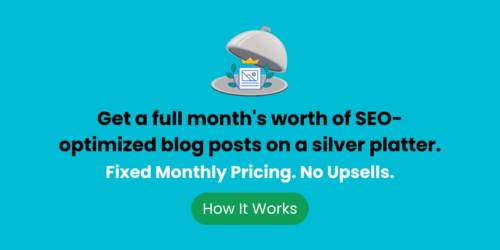Writing content that climbs to the top of Google’s rankings feels like striking gold. It drives traffic, sure, but it also builds authority and trust – two must-haves for any business aiming high. Let’s face it; we all want our words to be the ones people find when they’re searching online.
To get there, you need a solid game plan. This means digging into what your audience is hunting for with keyword research tools and crafting headlines that grab their attention. You’ll learn how an outline shaped by data can set up your article for success.
We’ll look at ways to keep readers hooked from the first sentence and show you how quality feedback before hitting ‘publish’ can turn good writing into great content.
Crafting Content That Drives Traffic
Ever feel like your content is a needle in the digital haystack? You’re not alone. With tons of articles being uploaded every minute, grabbing that spotlight on Google’s stage isn’t just about luck—it’s an art form.
Identifying High-Demand Topics
The first step to stardom is knowing what tunes the crowd wants to hear. Think keyword research tools are your A&R reps here; they spot the chart-toppers before they even hit the airwaves. By understanding what your audience craves, you create a backstage pass for them directly to your site. Ahrefs’ Keywords Explorer, for instance, doesn’t just guess what people want—it uses data to give you a list as accurate as Billboard’s.
Buckle up and dig into those search queries because when you match them with high-quality content, Google takes notice and bumps you up closer to that number one spot.
Understanding and Matching Search Intent
Your next move? Syncing up with why someone typed their question into Google in the first place—their search intent. When someone asks “How do I tie a tie?” they don’t want a history lesson on neckwear—they need clear steps, maybe some pictures or videos—stat. So if your page answers their call quicker than roadside assistance at 2 AM, congrats—you’ve got yourself a fan who might just stick around for more tips from you.
This alignment between user quest and content answer isn’t merely encouraged; it’s necessary because it speaks directly to relevance—one of Google’s love languages—and makes sure visitors find exactly what they were looking for when they land on your page.
No fluff here—we’re aiming straight for practicality because let’s face it: nobody has time for another run-of-the-mill article cluttering up cyberspace. We’re crafting masterpieces worthy of traffic jams—a true RankWriters symphony.
Key Takeaway: To hit the SEO jackpot, think like a music producer—use keyword research tools to find what your audience is craving and match it with quality content. Sync your answers to their search intent for a relevance that Google can’t ignore, creating not just traffic but fans.
The Art of Engaging Your Audience
Think about it: when you come across a headline that promises the world but delivers an atlas, how do you feel? Cheated, right? Well, crafting click-worthy headlines is more than just a bait-and-switch game. It’s an art form that blends curiosity with credibility.
For small to midsize businesses and professionals like attorneys or plastic surgeons, engaging your audience can turn one-time readers into long-term customers. The secret lies in making them think “Wow, I need this.” before they’ve even scrolled down. And let’s face it; everyone loves being part of something special – especially online where the competition for attention is fierce.
Crafting Click-Worthy Headlines
Your headline is your first handshake with the reader – make it firm and memorable. But remember: a great handshake isn’t followed by a limp conversation. When someone clicks on your content because of an irresistible headline, they’re expecting substance behind that style. To meet these expectations and maintain trustworthiness—which matters hugely for Google rankings—make sure every piece lives up to its opening promise.
Now imagine yourself at the busiest intersection in New York City—the Times Square of digital content—and there stands your article among thousands shouting for attention. If two main objectives are driving traffic to websites and converting audiences into customers as stats suggest then nailing those headlines becomes crucially important without veering off into clickbait territory.
Picture this: you’re crafting a master plan to conquer the digital landscape. That’s your SEO-driven content outline, and it’s not just a map—it’s the secret sauce that spices up your chances of ranking high in search results. A data-driven approach isn’t merely smart; it’s non-negotiable if you want Google to give your content a nod.
Digging into research can be as thrilling as a treasure hunt. You unearth gems of insight about what tickles the fancy of both readers and algorithms alike, making sure every topic under discussion is like hitting bullseye on an archery target—precise and on point.
A stellar outline backed by cold hard data does more than guide you; it ensures no stone goes unturned, covering all critical points with laser focus. The proof? It helps boost those odds for top rankings that we’re all after.
Identifying High-Demand Topics
You’ve got tools at your disposal like Sherlock Holmes has his magnifying glass. Keyword research tools are invaluable for pinpointing exactly what topics get hearts racing—and fingers clicking—in your niche.
Ahrefs’ Keywords Explorer, for instance, lets you dive deep into user psyche without getting wet—you’ll know precisely which conversations folks are itching to join online before they even start typing their queries.
Understanding and Matching Search Intent
The heart wants what it wants—and so does search intent. Aligning content with users’ innermost yearnings is key because relevance isn’t just king; it’s the entire kingdom when climbing Google’s ranks.
Analyze pages already perched at those coveted top spots through SEMrush. By mirroring their successful strategies while adding your unique twist, you’re not copying homework—you’re learning from valedictorians.
Crafting Click-Worthy Headlines
Your headline shouldn’t just turn heads; it should snap necks (figuratively speaking). Crafting one that grabs eyeballs takes finesse—a blend of wit and wisdom sprinkled with enough intrigue to draw clicks like moths to flame but delivering substance behind the sizzle is where true skill lies.
Key Takeaway: To dominate in Google rankings, treat your content outline like a treasure map; use data to target exactly what readers and algorithms crave. Nail the bullseye with topics that resonate deeply using tools like Ahrefs and SEMrush for insights into demand and search intent. Craft headlines that combine wit with wisdom—catching attention is key, but delivering on the promise secures success.
Optimizing Content Format for Readability
We all know the feeling of landing on a webpage only to be met with an impenetrable wall of text. It’s as welcoming as a brick wall in your path. You’re here because you want your content not just read, but enjoyed and understood—and that means making it as accessible and engaging as possible.
Your aim? To turn scanners into readers. How do we do this? Start by breaking up the monotony. Use headings, subheadings, short sentences, and even shorter paragraphs—like tossing breadcrumbs that lead them through the forest of information. Remember those essays from school with giant blocks of text? Let’s not revisit those days.
Headings: Your Guiding Stars
Imagine heading into battle without any strategy; that’s what reading unformatted content feels like. Headings are your game plan—they guide readers through different sections clearly while providing rest stops for their eyes along the way.
Actionable tip: Make sure each heading makes sense out on its own—it could be the only thing someone reads.
Kicking Clutter to The Curb
A cluttered room stresses you out just like cluttered writing does to your reader’s brain—it’s time for some spring cleaning. Each sentence should have breathing room so ideas can blossom rather than suffocate under fluff or jargon.
The Magic Number: Short Sentences & Paragraphs
If brevity is the soul of wit, then let’s get Shakespearean on our content. Aim for sentences under 19 words—you’ll keep things crisp and increase understanding at every comma stop.
Craft Subheadings That Carry Weight
No one likes getting lost in transition—subheadings prevent that ‘where am I?’ moment mid-scroll. They’re not afterthoughts; they’re signposts pointing toward value-packed passages ahead.
Leveraging Keyword Research Tools
Imagine trying to catch fish without knowing what kind they crave. That’s like creating content without keyword research tools—they’re your digital fishing rods, helping you reel in the right audience. Tools like Ahrefs’ Keywords Explorer aren’t just flashy gadgets; they’re essential for understanding search demand and traffic potential.
Identifying High-Demand Topics
The internet is a sea of information, and standing out means finding the right bait. With Ahrefs’ Keywords Explorer, it’s about pinpointing topics with enough search volume that signals strong user interest—this is how you know there are plenty of fish biting.
Digging into data helps you see beyond mere hunches, giving solid ground to base your content on. By targeting these high-demand areas, organic traffic becomes less a game of chance and more a result-driven strategy.
Understanding and Matching Search Intent
To truly connect with users through your writing, grasping their intent behind searches is crucial—it’s akin to choosing the right lure for different types of fish. Each query has an underlying purpose: some seek knowledge while others might be ready to purchase something.
Analyzing this aspect can shift odds in your favor because Google rewards content that fits snugly with what people want to find. And remember, matching intent isn’t just good SEO practice; it builds trust with readers by providing them exactly what they came looking for—a surefire way to keep them coming back for more.
Crafting Click-Worthy Headlines
Your headline works much like a storefront sign—it needs to draw people in but also promise an experience that lives up inside. Effective headlines pique curiosity or offer solutions compelling enough so readers feel compelled not only click but stay awhile too.
A mix of creativity backed by keyword insights can elevate headlines from mundane labels into powerful hooks capturing attention amidst endless scrolling feeds—and when those clicks turn into sustained engagement? Well now we’re talking conversion gold mines here folks.
The Power Of First Impressions
What greets visitors as soon as they land on a page often determines whether they stick around for the long haul, engage further, or convert into desirable actions such as subscribing, signing up for a trial, or purchasing a product or service. So, crafting an engaging introduction using the Attention, Interest, Desire, Action (AIDA) formula is key. Hook your audience from the get-go by showing them how you can solve their problems and warmly invite them to take that next step.
Key Takeaway: Use keyword research tools like Ahrefs’ Keywords Explorer to discover high-demand topics and match user search intent, ensuring your content stands out in a crowded online space. Crafting click-worthy headlines and engaging introductions using the AIDA formula will help turn visitors into loyal readers or customers.
The Power of First Impressions
Imagine the first bite of a perfectly cooked steak, how it sets the stage for your entire meal. That’s what an introduction does for your content. Using the AIDA formula, you grab readers by their curiosity and lead them down a path where taking action feels like their idea.
Crafting Click-Worthy Headlines
Your headline is the flashy sign that gets people through the door. Think about it; when you’re scrolling online, headlines are calling out to you from every corner of your screen. To stand out in this noisy world, yours has to be magnetic—enough to make someone stop mid-scroll—but honest enough so they don’t feel tricked after clicking.
So here’s our secret sauce: blend power words with a clear benefit and voila. You’ve got yourself something click-worthy without crossing into clickbait territory. It’s not just us saying this works—it’s also backed by data showing that meeting these two objectives drives traffic and engagement.
Identifying High-Demand Topics
You’ve likely heard “content is king,” but if nobody’s searching for what you’re writing about, then who are you ruling over? Empty space? Use keyword research tools—they’re like GPS devices pointing toward topics people actually care about. And let me tell ya’, finding high-demand subjects can be as satisfying as hitting all green lights on your way home during rush hour.
We don’t pull topics out of thin air—we use tools designed specifically for digging up those golden nuggets (aka keywords) that signal what folks want to read about now or in future trends which could skyrocket your traffic stats through organic searches.
The Art of Engaging Your Audience
An engaged audience sticks around longer than awkward relatives at Thanksgiving dinner—and trust me, engaging them isn’t nearly as hard as getting Uncle Bob off your couch before Monday rolls around again. Start with storytelling elements; because everyone loves a good story even more than leftover pie.
Create content that solves problems faster than MacGyver with duct tape while maintaining relatability—as though chatting across kitchen tables rather than shouting from mountaintops—to keep those eyes glued until they reach actionable steps presented crystal-clearly at journey’s end.
Key Takeaway: Make your content’s first impression unforgettable, like the taste of a perfect steak—use AIDA to captivate and motivate readers.
Create headlines that are irresistible yet genuine by mixing power words with clear benefits—this approach is proven to boost traffic and engagement.
To reign supreme in content creation, find what people crave using keyword tools—it’s like hitting all green lights during rush hour for your traffic stats.
Engage your audience with compelling storytelling and relatable problem-solving—they’ll stick around longer than unwanted house guests.
Enhancing Content Quality through Feedback
You’ve probably heard that feedback is the breakfast of champions. Well, it’s also the secret sauce for content creators aiming to serve up Google-ranking gourmet. Think about it: getting honest, unfiltered thoughts on your drafts can turn a good piece into a great one.
We’re talking value boost here. When you ask someone to weigh in on your work before hitting publish, they might catch things you missed—like an awkward phrase or a point that needs clarifying—which helps make sure readers get what they came for.
The Impact of Real Opinions
Sometimes we writers are too close to our work; we need fresh eyes. And not just any eyes—we need people who will tell it like it is without sugar-coating their words. By tapping into this goldmine of insights from colleagues or even members of your target audience, you’re not only polishing your content but also fine-tuning its relevance and effectiveness.
This isn’t guesswork either; studies show quality improvement directly correlates with incorporating diverse perspectives early in the creative process.
Beyond Just Corrections
Gathering feedback doesn’t just help fix errors—it enlightens us on how our message resonates (or doesn’t). Sometimes what makes perfect sense in our heads falls flat with others because context varies wildly between individuals’ experiences and knowledge bases.
And there’s more than pride at stake here. Google loves valuable content—stuff that answers questions thoroughly and provides an enjoyable reading experience—and so do readers. So when folks give their two cents before publication, they’re helping ensure both humans and search algorithms find worthiness within those lines of text.Aligning Content with Top-Ranking Pages
If you’re looking to rank, think of Google as that picky eater at the dinner table. Just like how they only want grandma’s famous lasagna recipe, Google has a particular taste for content too. To please this digital gourmet, your best bet is serving up what’s already getting applause: top-ranking pages.
Analyzing these pages isn’t just smart; it’s like having the secret sauce. These pages are winning in search results because they nail user intent – understanding and matching this can boost your own content’s relevance on Google dramatically. It’s not about copying; it’s about learning from the best.
Key Stats: Understanding Search Intent Is Crucial for Creating Content That Ranks
You know those stats that make you go “wow”? Well, here’s one: aligning with search intent can significantly increase your chances of ranking well in search engines. But let me tell you something even more critical than just throwing facts around – firsthand experience beats theory every time when crafting SEO gold.
I’ve seen articles jump rankings simply by tweaking their angle to match what people actually want to know about a topic – talk about a game-changer. So remember, next time you’re tempted to write another generic piece on ‘The Best Gardening Tools,’ ask yourself if maybe folks are really after ‘How To Choose The Right Shovel For Clay Soil.’ Specificity is key.
To get there, start dissecting those high-flyers already perched atop SERPs (Search Engine Results Pages). Look at their structure – do they use lists or bullet points? Check out their headings and subheadings too; these elements guide readers through the page effortlessly while making sure scanners still catch all juicy bits of information quickly.
Last but not least, keep sentences punchy and paragraphs tight-knit because nobody wants to wade through fluff—your readers will thank you with longer stays and lower bounce rates which sends good vibes back to our friend Google who then might invite more guests over (to your website). Now isn’t that worth raising a glass… or should I say keyboard?
Key Takeaway: To rank well, think like Google and feed it what it craves—content that mirrors the top dogs. Analyze those pages for their secret sauce: they get user intent right. To hit SEO gold, tailor your angle to match real questions people have, making sure you’re specific.
Dissect winning content’s structure and emulate elements like bullet points or subheadings for easy reading. Keep things concise; clear content keeps readers hooked longer, which Google loves.
Conclusion
Remember, the key to how to write content that ranks in Google is simple. Start with what your audience needs. Nail those click-worthy headlines.
Outline with data-driven precision. Keep every paragraph digestible and engaging.
Leverage keyword tools like a pro. Hook readers fast, then hold their interest tight.
Solicit honest feedback – it sharpens your message until it cuts through the noise.
Mirror top pages but make sure you shine brighter. That’s how your content takes flight.
You’ve got this!







